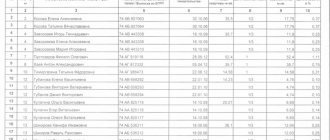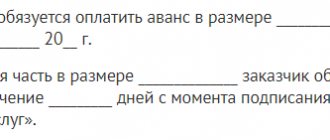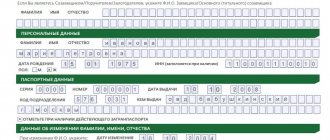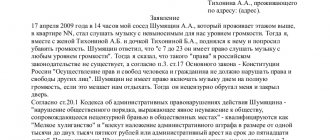Reasons for preparing a return note
The recipient has the right to return the goods to the supplier in the following cases provided for by the Civil Code of the Russian Federation:
- The supplier did not hand over accessories and documents related to the goods on time (Article 464 of the Civil Code of the Russian Federation);
- The supply contains less goods than stated in the contract (clause 1 of Article 466 of the Civil Code of the Russian Federation);
- The assortment does not comply with the contract in whole or in part (clause 1 and clause 2 of Article 468 of the Civil Code of the Russian Federation);
- The requirements for the quality of the goods or part of the goods included in the set have been violated (clause 2 and clause 4 of Article 475, clause 2 of Article 520 of the Civil Code of the Russian Federation);
- The supplier did not comply with the buyer’s requirements to complete the goods (Clause 2 of Article 480 of the Civil Code of the Russian Federation);
- There are no containers or packaging or they are of inadequate quality (Article 482 of the Civil Code of the Russian Federation).
MARCH on the execution of acts upon return of goods by the consumer
On December 23, 2018, MARCH Resolution No. 85 came into force, establishing the forms of the act of transfer of goods and the act of completion of work to eliminate defects of the goods free of charge. MART answered the questions that arose.
Resolution No. 85 “On measures to implement the Law of the Republic of Belarus “On the Protection of Consumer Rights” establishes the forms of the act of transfer of goods and the act of work performed to eliminate defects of the goods free of charge. Are trade entities required to use the forms of acts established by Resolution No. 85 “On measures to implement the Law of the Republic of Belarus “On the Protection of Consumer Rights”? Can a trade entity use regulations developed independently?
Business entities are obliged in their activities to use the forms of acts established by Resolution No. 85 “On measures to implement the Law of the Republic of Belarus “On the Protection of Consumer Rights”.
When the consumer transfers the goods to the seller (manufacturer, supplier, representative) in connection with the exercise of the right provided for in subsection. 1.1 clause 1 art. 20 of the Law on the Protection of Consumer Rights, as well as to carry out a quality check of the goods or an examination of the goods, an act of transfer of goods is drawn up in the form established by MART <*>.
When the defects of the product are eliminated free of charge, the repair organization fills out a warranty card, handed over to the consumer simultaneously with the product upon purchase, and if it is not available, a document is drawn up confirming the defects of the product were eliminated free of charge, in the manner and form established by MART <*>.
Based on the above norms, business entities engaged in trade and services are obliged in their activities to use the forms of acts established by paragraph 2 of Resolution No. 85 “On measures to implement the Law of the Republic of Belarus “On the Protection of Consumer Rights”.
Who is responsible for filling out (drawing up) the act of transfer of goods (consumer, seller)?
From paragraph 14 of Art. 20 of the Law on the Protection of Consumer Rights it follows that the act of transfer of goods must be drawn up by the business entity to which the consumer has applied. The act of transfer of goods is drawn up according to the consumer in two copies and signed by the seller and the consumer. One copy remains with the seller (manufacturer, supplier, representative), the second is transferred to the consumer.
How is the value of the goods determined for filling out the goods transfer certificate?
The cost of the goods is determined based on the documents submitted by the consumer (for example, originals or copies of a cash receipt, sales receipt and other document confirming the fact of purchasing the goods from the seller indicating the cost of the goods), at the selling price of such goods on sale from this seller ( manufacturer, supplier, representative), and in case of its absence, when calculating the price of goods, one should be guided by clause 1 of Resolution No. 85 “On measures to implement the Law of the Republic of Belarus “On the Protection of Consumer Rights”.
Is the consumer obliged to hand over the product for repair (free elimination of defects in the product) in a complete set (for example, with a hair dryer attachment or a charger for a mobile phone, a TV remote control, etc.)? Does the seller of goods, when filling out the value in the act of transfer of goods, have the right to withhold the value of the amount of money by which the value of the goods has decreased due to partial use of the goods, lack of equipment (lack of an attachment for a hair dryer or a charger for a mobile phone, a remote control for a TV, etc.) ?
When returning to the consumer the amount of money paid for the goods, the seller (manufacturer, supplier, representative) does not have the right to withhold from it the amount by which the value of the goods has decreased due to full or partial use of the goods, loss of their marketable condition or due to other similar circumstances, as well as require the consumer to present an identification document, except for the case if the data of the consumer’s identification document was used when concluding the contract <*>.
The Law on the Protection of Consumer Rights does not provide for the consumer’s obligation to hand over the goods for repair in a complete set, in packaging.
In view of the above, in the event of a consumer returning a defective product or a consumer transferring a product for repair, the seller (manufacturer, supplier, representative) is obliged to accept the product of inadequate quality, including the product not fully equipped (for example, a mobile phone without a charger, a hair dryer without attachments and packaging etc.), without packaging and satisfy the legal requirements of the consumer without deducting the amount of wear and tear and the amount by which the value of the product has decreased due to loss of appearance or other similar circumstances (for example, the absence of a hair dryer attachment or a charger for a mobile phone, a remote control to TV, etc.).
In the act of transfer of goods there is a line “accompanying documents”. What documents should be included in it?
The given line in the act of transfer of goods indicates those documents that are presented by the consumer when making a claim regarding the goods to the seller (manufacturer, supplier, representative).
Such documents include a cash receipt (original or copy), warranty card, technical passport and other document confirming the fact of purchasing the goods from the seller.
Is a business entity obliged to send the completed goods transfer act (copy), signed by the consumer, to an authorized service center?
Resolution No. 85 “On measures to implement the Law of the Republic of Belarus “On Protection of Consumer Rights” does not provide for the obligation of the seller (manufacturer, supplier, representative) to transfer the act of transfer of goods or a copy thereof upon further transfer of the goods to a service center of a third party organization and (or) to experts when carrying out an examination of the quality of goods.
At the same time, in view of the indication in the acceptance certificate of the goods of the defects present in the goods, the description of the condition of the goods, as well as the consumer’s demands made in relation to such goods, and in order to have evidence for the seller in the event of questions arising with consumers regarding the appearance of the goods and its implementation stated requirements, it is recommended to send a copy of this act to service centers along with the product.
Deadlines for submitting a return invoice
The return date depends on the expiration date of the goods and the warranty period. The conditions provided for by the Civil Code of the Russian Federation are described below. If the agreement between the supplier and the buyer stipulates other conditions, then the return occurs in accordance with them.
If defects are found during the warranty period
The product can be sent back within this period. Sometimes the contract specifies a shorter or longer period for components for the main product. In this case, a return is possible within the longest period (clause 3 of Article 477 of the Civil Code of the Russian Federation).
Example
The warranty on the washing machine is 3 years, and the hose from it is 1 year. Two years after the goods were received, the recipient discovered that the hose was of poor quality. For this reason, the machine can be returned even if the warranty on the hose has already expired, because the law allows for a period of 3 years.
If defects are found when the expiration date has already expired, but 2 years have not passed from the date of delivery
You can send the goods back if you prove that the goods had defects even before they were transferred into the ownership of your company (Clause 5 of Article 477 of the Civil Code of the Russian Federation).
Example
While selling the phone in a retail store, it turned out that it would not turn on. The examination showed defective soldering, which means the product can be returned to the supplier even if its six-month warranty has expired.
If the product has an expiration date
You can return the product as long as its expiration date has not expired (Clause 4, Article 477 of the Civil Code of the Russian Federation). The expiration date can be found in the product documents or on the packaging.
If there is no warranty period or expiration date
The goods can be returned within a “reasonable period”, but no more than two years from the date of delivery of the goods to the recipient, including by mail (clause 2 of Article 477 of the Civil Code of the Russian Federation).
Accompanying documents for the return invoice
The return of goods is issued not only with a return invoice. The following documents must be attached to it:
- Acceptance certificate - confirms the fact of receipt of the goods.
- Letter of complaint - serves as a notification that the supplier has violated the terms of the contract (on quantity, assortment, quality, completeness, containers or packaging). Without notification, the supplier may refuse to return the money (clauses 1 and 2 of Article 483 of the Civil Code of the Russian Federation).
- A certificate of defects in goods is needed if you are returning the goods due to defects.
Letter of claim for return of goods. Sample
Download a blank form in *rtf format.
A letter of complaint can be drawn up in any form. What must be included in the letter:
- Reason for return. Refer to the provisions of the Civil Code of the Russian Federation that apply to your situation (they are listed above);
- Return deadlines;
- Terms of delivery or removal of goods;
- Method of transferring money for returned goods and bank details.
You can attach copies of documents related to the subject of the transaction to the letter. For example, a delivery agreement, a bill of lading, a report on identified defects in goods, a payment order, a power of attorney.
Act on defects of goods. Sample
Download a blank form in *rtf format.
Draw up a report on deficiencies in free form. What should be in the content:
- number and date of the act;
- characteristics of the goods and price indicated in the invoice;
- how the deficiencies were discovered (visual inspection, disassembly, examination, etc.) and what they were;
- whether the product is under warranty;
- what was decided to do with the low-quality product (return to the supplier, repair, write off, etc.);
- Full name and position of the employees who identified the defect and executed the report. If this is a specially created commission, refer to the order or directive of the head of the organization on the creation of the commission.
What to include in the goods acceptance certificate
It was mentioned above that the goods acceptance certificate must contain some mandatory details, in particular:
- Name (act of acceptance and transfer of goods), date and place of its preparation.
- The preamble must indicate within the framework of the execution of which contract the act of acceptance and transfer of goods is drawn up, as well as the names of its parties. If the act is drawn up between legal entities, then their names, full names of representatives are indicated and references are made to the document on the basis of which the representatives participate in the preparation and signing of the act (if this is a manager, then his powers are enshrined in the statutory documents, and if the representative is an employee of the organization, then his powers can be specifically reflected in the same documents, or a power of attorney is issued in his name, data that must be reflected in the act). If the parties to the agreement are individuals, then the act reflects their names, passport details, and place of registration.
- Full description of the transferred goods (article, brand, model, quantity, unit cost and total cost of the goods).
- Information about identified defects or the absence thereof, about violation of the terms of delivery of the goods (it should be noted that an indication of the absence of identified defects in the goods does not deprive the recipient of the opportunity to make quality claims after acceptance within the time limits established by law or contract).
- The text of the acceptance certificate for the transfer of goods is completed with personal signatures of the participants in the acceptance and transfer procedure, as well as seals (if any).
the act can be free by clicking on the picture below:
About the form that must be drawn up if, at the time of acceptance of the goods, discrepancies are identified in its quantity and quality with the data specified in the shipping documents, read the material “Unified Form Torg-2 - Form and Sample”.
What to do if you find defects in the product after signing the acceptance certificate? Study the answer to this question in Consultant Plus. If you do not have access to the K+ system, get a trial online access for free.
Rules for filling out the return invoice form
Until 2013, it was possible to draw up primary documents only using unified forms; now invoices can be filled out in the way that is convenient for the organization (Clause 4, Article 9 of the Federal Law of December 6, 2011 No. 402-FZ).
The main thing is that the document contains all the details necessary for primary accounting (clause 2 of article 9 No. 402-FZ):
- name and date of the document;
- name of the organization or individual entrepreneur who compiled the document;
- what is the fact of economic life;
- unit of measurement and cost of goods;
- position, full name and signatures of the persons who made the transaction;
- position, full name and signature of the person responsible for processing the transaction.
For invoices, there was a TORG-12 format; it is no longer required, but it continues to be used for processing receipts and returns.
Receipt invoice TORG-12. Sample
Download a blank form in *xlsx or *rtf format.
The return invoice can be issued manually or automatically using the Kontur.Market service, which is much faster. We will show you how to create an invoice based on the usual TORG-12 form.
Manually issuing a return note
1. Download a blank form in *rtf or *xls format
2. Enter information about the recipient and supplier. In the event of a return, your store becomes the sender, and your supplier becomes the recipient. This process is called resale.
Please note the differences in the header of the receipt and return invoice:
3. On the right side, add the remaining details; they can be taken from the invoice.
4. In the tabular section, enter the name, quantity, price and other data about the product you are returning.
Please note the differences in the tabular part of the receipt and return invoice:
5. At the bottom of the return invoice, indicate the remaining details, using the delivery note as a sample.
6. Sign the document with the responsible persons indicated in the document.
Automatic creation of a return invoice in the Kontur.Market service
Kontur.Market helps you avoid wasting time reprinting details from the delivery note to the return one. All the details that are in the service can be added to the document with one click. Work in the “Invoices” section.
1. Select the “Expense” subsection, click “Create an invoice” and click “Return”.
2. Enter the document number and select a date on the calendar. Click in the “Consignee” field and select the desired company in the list that opens. To add a product, click in the empty field and start entering the name, barcode or article. The service will offer to select the desired option from those found.
3. Specify the quantity of the item being returned, and the service will automatically calculate the refund amount. To post the document after filling it out, click “Add invoice”. It can be printed.
Form for acceptance and transfer of goods
Organizations usually have ready-made forms for such acts, created by developing them independently, so all that remains is to fill them out carefully in order to avoid unpleasant moments later.
For information on the form of the document used for acceptance of goods by the buyer, read the article “Unified Form TORG-1 - Certificate of Acceptance of Goods”.
We will talk in more detail about the details that must be present in the acceptance certificate of goods.








